Letters from Lodi
An insightful and objective look at viticulture and winemaking from the Lodi
Appellation and the growers and vintners behind these crafts. Told from the
perspective of multi-award winning wine journalist, Randy Caparoso.
Everything you need to know about Assyrtiko, a Lodi wine of the future
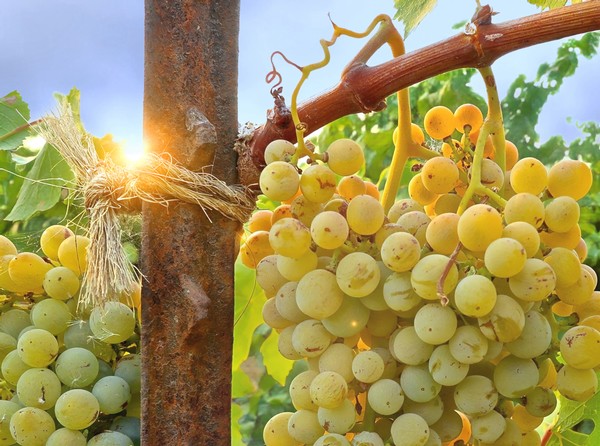
Perlegos Family grown Assyrtiko, tailor made for Lodi's Mediterranean climate and sun.
A white wine of the (near) future
Prediction: In about 25 years time, Assyrtiko will become a major grape of the Lodi wine region.
Not "major," mind you, in the same way as high-demand wine industry grapes such as Cabernet Sauvignon or Chardonnay. According to the most recent California Grape Acreage Report (April 2024), there are currently 14,102 acres of Cabernet Sauvignon and 12,191 acres of Chardonnay cultivated in the Lodi appellation (classified as District 11 by the USDA).
But "major," perhaps, in a way that Albariño has become extremely important to Lodi; to the point that, among local wineries, there are more brands of Albariño than there are of Chardonnay or Sauvignon Blanc. It's taken just over 25 years for Albariño to reach that status in Lodi, despite the fact that there are just 223 acres of the grape growing in the region.
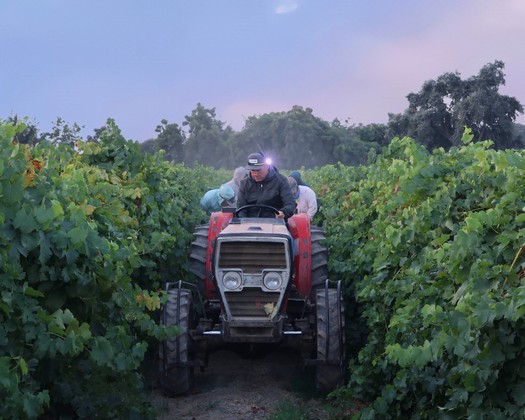
Jeff Perlegos manning the tractor during the 2023 Assyrtiko harvest in Perlegos Family's Thera Block, Clements Hills-Lodi AVA.
The reasons why Albariño has become identified with Lodi are simple:
1. The grape has proven to be extremely well adapted to Lodi's Mediterranean climate and wine friendly soils (ranging from deep sandy loams to shallower clay loams).
2. Wine quality is high, distinctive, and very much appealing to the current consumer taste for fairly crisp (i.e., retaining lively acidity) and light dry white wines, combining citrus, floral and mineral characteristics in the fruit profile.
Assyrtiko has many of the same attributes you find in Albariño; and because of its fuller bodied quality, perhaps even more.
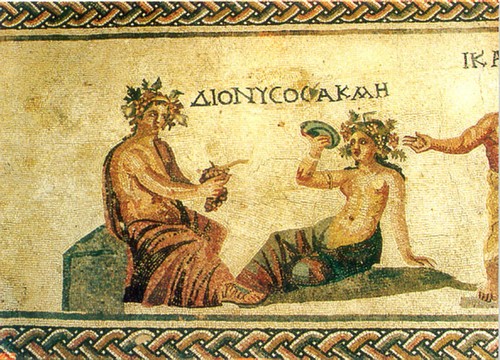
Ancient Hellenistic mosaic depicting Dionysus, the Greek god of wine, uncovered near the city of Paphos. Public domain.
First, the basics: Assyrtiko (pronounced ah-SEER-tee-koh) is a white wine grape indigenous to Greece, where winegrowing has been dated back as far as 6,500 years ago. Among the 30 or so major native white wine grapes grown in Greece, Assyrtiko is easily the best known and most widely exported.
While, most certainly, American consumers are far more familiar with grapes of French origin, such as Chardonnay and Sauvignon blanc, Greece's visitor industry has grown in leaps and bounds over the past twenty years⏤more than 120% just since 2019 according to etias.com (which tracks the travel industry in Europe).
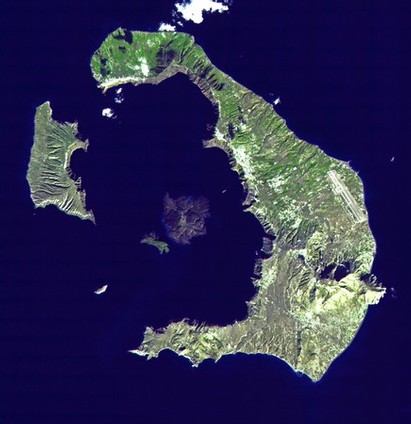
Satellite view of the Santorini showing the caldera of the ancient volcano that separated the main island of Thera (right) from Therasia (left).
Many of Greece's visitors flock to Santorini, the scenic ancient volcanic island in the Aegean Sea where reputedly the finest white wines made from Assyrtiko are grown. Hence, Greek Assyrtiko has steadily become more familiar to American consumers who have either been to Greece or have heard all about it; similar to the way Albariños imported from Spain began to pop up on wine store shelves across the country in the early 2000s.
Lodi's resident experts on the Assyrtiko grape are Jeff and John Perlegos, second generation Lodi grape growers of Greek descent. In recent years the Perlegos brothers have also branched out into winemaking, producing wines under the Perlegos Family Wine Co. brand.
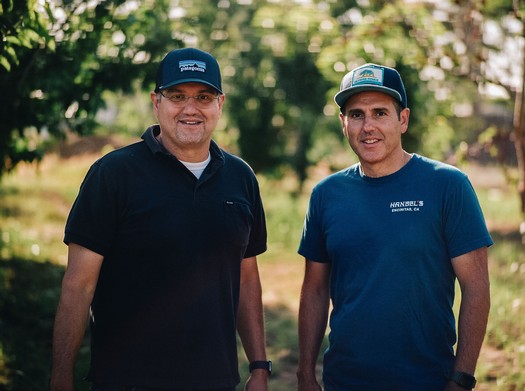
Second generation Lodi grape growers/vintners John (left) and Jeff Perlegos. Perlegos Family Wine Co.
I asked the Perlegos brothers about their personal experience with Assyrtiko, and they said...
We have both been to Santorini several times throughout our lives during trips to Greece. Naturally we have explored the vineyards and wineries of the island, which was when we were first exposed to Assyrtiko, and Assyrtiko-based wines. At first, not much of the wine left the country, but as it became more readily available in the states we were also able to enjoy it more often, and eventually really fell in love with it.
At some point we started to think about how amazing it would be to grow it in one of our plots in Lodi to see what it could do. We know enough to be able to recommend what we think are the best producers in Santorini, such as Sigalas, Canava Chrissou and Hatzidakis. Off the island in Northern Greece, we also like Ktima Biblia Chora.

Young, own-rooted Assyrtiko in Perlegos Family's Grecque de Pied vineyard, growing in deep sandy loam on the east side of Lodi's Mokelumne River AVA.
Who knows? Someday wine lovers around the world may talk about "Perlegos Family" in the same way when bringing up the finest Assyrtikos of the world. When asked exactly what's so special about the grape and wine, Jeff and John were at no loss for words, telling us...
There are numerous white grapes grown in Greece but few match the intensity of flavor of the Assyrtiko. This isn't just as a "wine"⏤the varietal's intensity of flavor starts with the grape itself. If you have ever had the chance to taste an Assyrtiko grape, you'll know what we mean. It stands out in the crowd, even in comparison to Chardonnay or Sauvignon blanc. It is unique, distinct, and encompass both power and elegance at the same time. We strongly believe Assyrtiko is capable of producing world class wines!
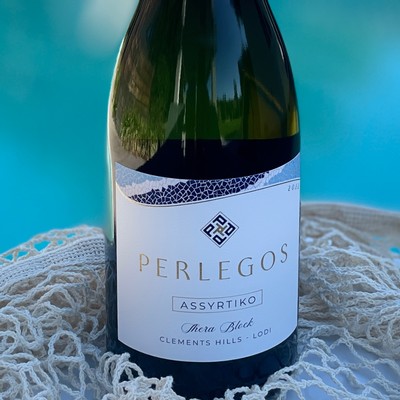
The latest Perlegos Family Assyrtiko releases
This past weekend the Perlegos brothers unveiled their two most recent bottlings of Assyrtiko⏤their third commercial vintages⏤from their recently planted blocks.
First, the 2023 Perlegos Family Thera Block Clements Hills-Lodi Assyrtiko ($29) is fragrant with wildflower, lemony citrus, a drop of honey, and a distinct minerality reminiscent of sea salt in both the nose and its crisp, lively, upbeat medium-full body (weighing in at 13.8% alcohol). The wine, which finishes bone dry, was half-fermented in neutral French oak to help round out the grape's naturally high acidity, while the stainless steel fermented half helped the varietal retain its intrinsically crisp, mouth watering, exuberantly honeyed fruit qualities.
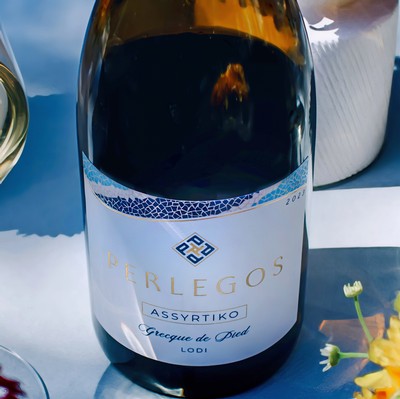
The 2023 Perlegos Family Grecque de Pied Mokelumne River-Lodi Assyrtiko ($30) comes from a smaller (literally, just a sliver of a) block located on the east side of the Mokelumne River appellation where the sandy soil is the deepest in Lodi (the Thera Block Assyrtiko in Clements Hills is also grown in sandy loam because the planting is located on a bench running alongside the Mokelumne River, below the transition to shallow clay slopes more typical of the sub-appellation). Also unlike the Thera Block, Grecque de Pied was planted on its own roots. Consequently, the wine is a tad lighter in mouth-feel than the Thera bottling (13.1% alcohol) and expresses even more minerality (think of stones and sea brine) than its counterpart; the floral and lemon citrus fruit profile woven into a subtle cream-like texture derived from 100% neutral oak barrel fermentation on native yeast (aged strictly in steel tanks for 6 months before bottling).
Everything else (or just about) anyone needs to know about Assyrtiko
After tasting the two latest releases, I asked John and Jeff to expand even further on the grape. Since, of course, we live in such an Assyrtiko-friendly wine region, it behooves us all to become resident "experts" on the varietal. Our conversation with the two brothers, combining their responses into one voice...
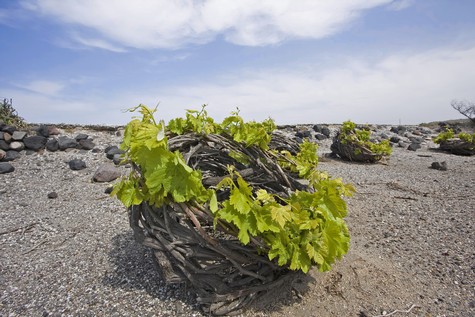
Koulora ("basket") trained Assyrtiko on the island of Santorini. winewitandwisdomswe.com.
What, so far, have been the differences between Assyrtikos from Greece and your Lodi Assyrtikos?
We really need more time to answer that question properly as we gain more experience on both the viticultural and winemaking side. One big difference is the age of the vines, which of course will change as time goes by. However, vines in Santorini can be up to 200-300 years old according to some of the producers, with most falling in the 40 to 80-year range. And of course, their viticulture is different from ours.
In Santorini, Assyrtiko is trained as koulora [i.e., "basket" shaped plants}. When the koulora gets big, they cut it off and restart it from the ground, while the roots remain unaffected. So far we have found that Assyrtikos from Greece are a bit more fuller bodied than ours; picked at higher levels of sugar and often finished with some unfermented sugar, while still maintaining very low pH [i.e., measure of acidity] in the grapes.
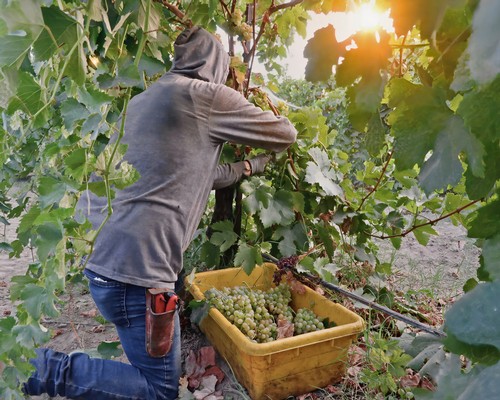
Harvesting 2023 Assyrtiko under the canopy of trellised vines in Perlegos Family's Thera Block.
There is this idea that Assyrtiko is a very high acid wine. It is, to a point⏤if we measure acidity by pH we would say it very much is a high acid varietal. Finished pH seems to be in the range of 2.9 to 3.3 at 13.5-15% alcohol. But titratable acidity is more in line with other white wines around the world⏤which is a great accomplishment in an environment as hot and arid as Greece. In Lodi, so far, we are seeing pH that is a little bit higher than this⏤3.1-3.35 pH at alcohols in the 13-14% range, with an elevated acidity similar to what you find in Greece.
Interestingly, there is also a second method of vine training used in Santorini for the less windy areas called "Kladeftiko." These vines are a little bit more like bush vines [i.e., similar to head trained vines in California], configured with 3-6 arms that carry both a 2-bud spur for renewals and a cane that is tied in a small circle onto itself.

Assyrtiko harvest in Perlegos Family's Thera Block, located on a sandy riverside bench in the Clements Hills-Lodi AVA.
Do you think Lodi has the right climate and/or terroir for Assyrtiko?
There is no place on earth that can reproduce the terroir of Santorini, period. The soils are volcanic based, consisting of basalt, white ash, sand and volcanic pumice of various colors. The pH of the soil is also very high, close to 8.0. Lodi's soil is dramatically different, being mostly sand from granitic sources and a pH of 6-7 [our note: higher pH soils tend to produce wines higher in acidity].
However, we do share similarities in that our soils are also very well draining, although the more important factor is climate and how the grape responds to it. Lodi has a Mediterranean climate similar to Santorini's—hot summers with cool nights. So far we are quite pleased with the results and expect to fine tune the wines as our vines get older and we accumulate more experience in the winery.
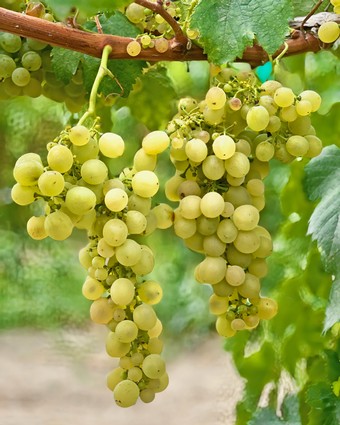
Small, loose Assyrtiko cluster in Perlegos Family's Grecque de Pied vineyard, Mokelumne River-Lodi AVA. Perlegos Family Wine Co.
We are not trying to reproduce Santorini, which would be impossible anyway, but we are trying to make a world class Assyrtiko appropriate to our own terroir. The wines, in fact, have similar flavor profiles. Although our wines taste very much like Assyrtiko, we still want them to taste like "California," not like Santorini or other regions.
Tell us about the names of your two plantings, Thera and Grecque de Pied, and what makes them different.
First, the Thera Block: Thera, or Thira, is the original ancient Greek name for Santorini, and the official current name for the island. Santorini is the name that the Venetians gave the island when they colonized it, naming it after the Santa Irini Church [dedicated to Saint Irene].
The current Santorini PDO [i.e., Greek appellations recognized by a "Protected Designation of Origin"] encompasses the island of Santorini as well as a small island across from it called Thirasia, which was once connected to the major island before an ancient volcano blew them apart⏤something you can tell just by looking at a map.
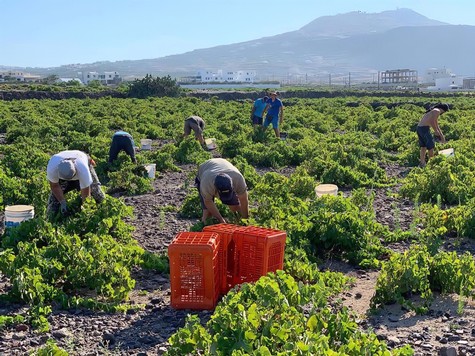
Harvesting of low-lying koulora trained Assyrtiko in Santorini. karakasis.mw.
On the Grecque de Pied, which was our first planting, on the east side of the Clements Hills AVA: Grecque de Pied is a play on the French phrase Franc de Pied, meaning "own-rooted." The names denote the differences between the blocks. The Assyrtiko in Grecque de Pied was planted on their own rootstocks. Thera Block in Clements Hills was grafted on to pre-existing vines originally planted [on 5BB rootstock) in 1977.
How do these differences affect the sensory qualities of the wines?
Our Assyrtiko on rootstock has tended to put out bigger clusters with bigger berries of fruit, while the own-rooted vines give medium sized clusters with very small berries. Both blocks produce fruit with high amounts of acid, so in that sense they are the same. However, I would say that, so far, the wines from the own-rooted vines have been more minerally and saline driven, while the wines from vines on rootstock have more of a citrus element, plus more thiols [i.e., aroma compounds] perceived in the nose.

John and Jeff Perlegos harvesting their Grecque de Pied vineyard.
What do you think of how your Lodi Assyrtikos have been developing in the bottle?
We need more time to understand how these wines evolve, although so far we can see that they are able to retain the citrus and mineral components expected out of the varietal. We have learned that Assyrtiko can add a good amount of weight⏤more than other white wines⏤so that is something to consider while making the wine and monitoring it through élevage [i.e., handling between fermentation and bottling]. More importantly, the wines have been able to preserve a freshness that even aged Santorini whites seem to retain, which is our ultimate goal. We are aiming to grow Assyrtikos capable of a similar evolution of flavors, while also retaining a steadfast sense of freshness.
How have the wines changed as you've made the adjustments in farming and winemaking while the vines mature?
One thing we learned in the first few years was viticultural. As mentioned earlier, vines on Santorini are grown in distinct basket shapes in order to offset the powerful Aegean winds. When we first planted and started growing our own-rooted vines, we were on the path to head-prune them. At first we were having issues getting much fruit from the vines. All of that Greek School our parents sent us to as children paid off since we were able to read in a Greek article about how Assyrtiko fruits poorly from a basal bud (i.e., the bud growth located at the base of a shoot or spur].
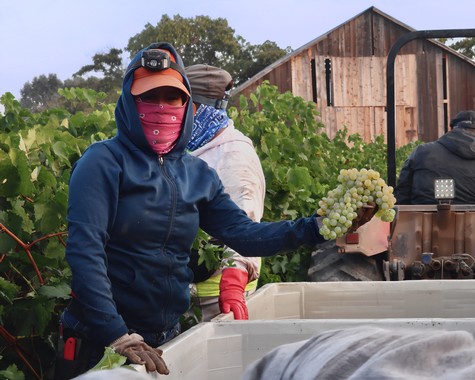
Generously sized Assyrtiko clusters in Perlegos Family's Thera Block, on a sandy bench in Lodi's Clements Hills AVA.
More importantly, we had a powerful wind storm in the spring a few years back that broke off a good percentage of our young shoots. That's when we learned first hand that young Assyrtiko shoots can be brittle, and that the basket provides support for the young shoots as they they are all leaning up against each other, supporting one another and keeping them from breaking. We realized that the basket training was, in effect, a different way of cane pruning. With a bit of adjustments to out trellis, we are now able to protect our vines from wind and also get reasonable yields at the same time.
On the winemaking side, we have learned that Assyrtiko, as mentioned earlier, can add weight after a time in the bottle. Therefore, our efforts have been focused on lowering yields in order to to ripen fruit a little sooner, and harvesting at just a tad higher, yet reasonable amount of, Brix (i.e., sugar reading], and even lower pH [to achieve higher acidity].
Our goal in the end is to make a wine that rides that fine line of balance⏤a richness coming from a little bit of weight of alcohol, with fruit extract balanced by higher acidity and a low pH to bring out the saline and mineral components which make Assyrtiko so unique, compared to almost any other white wine in the world.
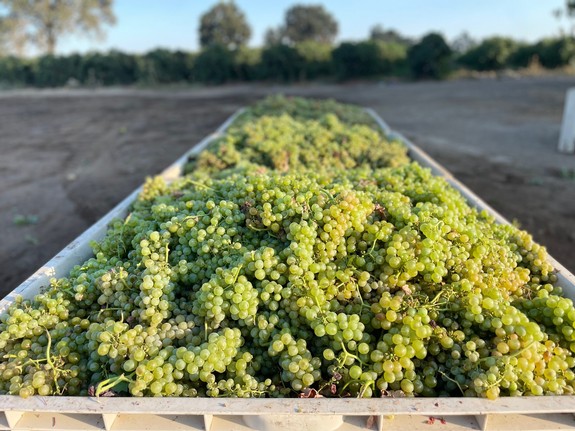
Perlegos Family Assyrtiko harvest.